
Cirkit Designer
Your all-in-one circuit design IDE
Home /
Component Documentation
How to Use 4way channel relay: Examples, Pinouts, and Specs
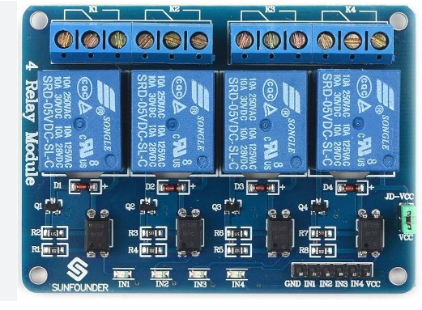
 Design with 4way channel relay in Cirkit Designer
Design with 4way channel relay in Cirkit DesignerIntroduction
The 4-Way Channel Relay Module, manufactured by SONGLE (Part ID: RELAY MODULE), is an electromechanical switch that allows you to control four separate circuits using a single control signal. This module is commonly used in automation and control systems to manage multiple devices or loads. It is ideal for applications where multiple devices need to be controlled independently, such as home automation, industrial automation, and robotics.
Explore Projects Built with 4way channel relay
Battery-Powered 4-Channel Relay Control with LED Indicators
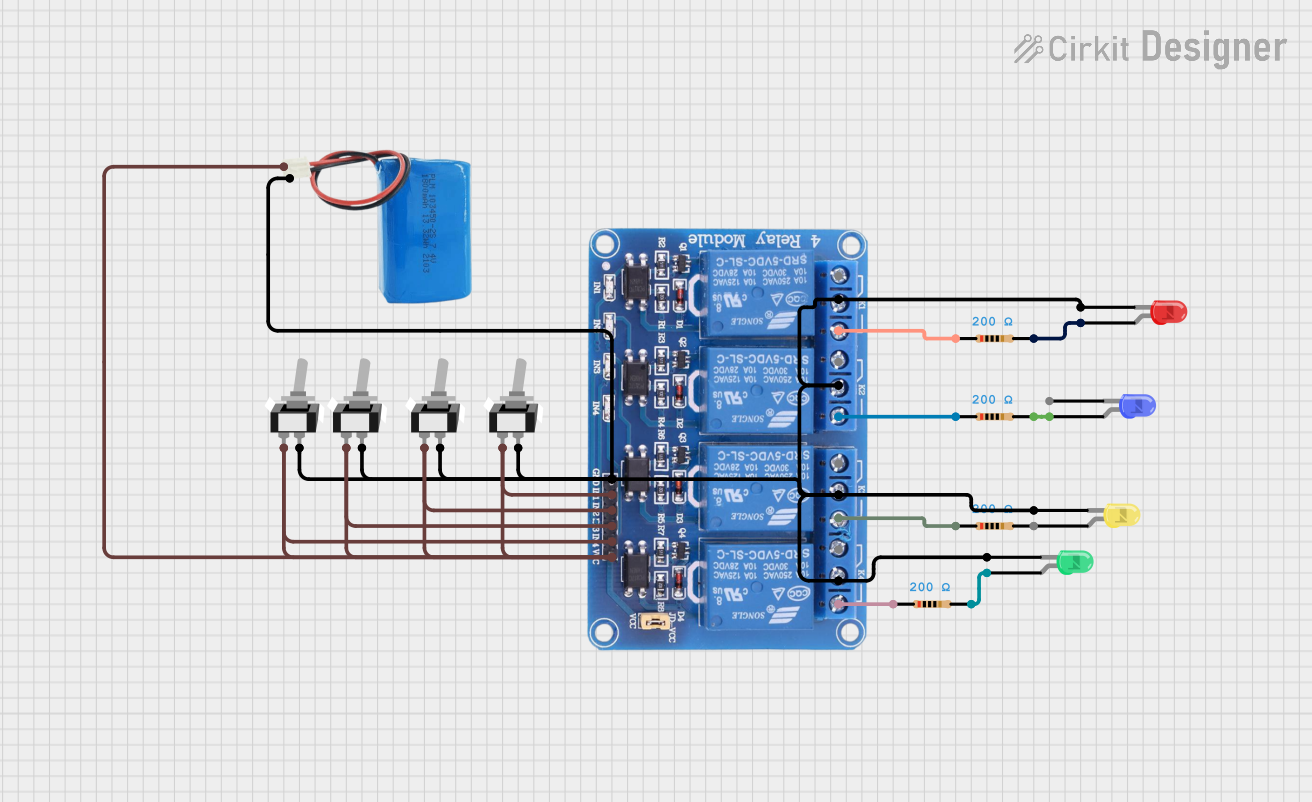
This circuit consists of a 5V battery powering a 4-channel relay module, which controls four LEDs (red, yellow, green, and blue) through individual resistors. Each relay channel is activated by a corresponding SPST toggle switch, allowing manual control of the LEDs.
 Open Project in Cirkit Designer
Open Project in Cirkit DesignerArduino UNO Controlled Smart Lighting System with Relay and Micro Switches
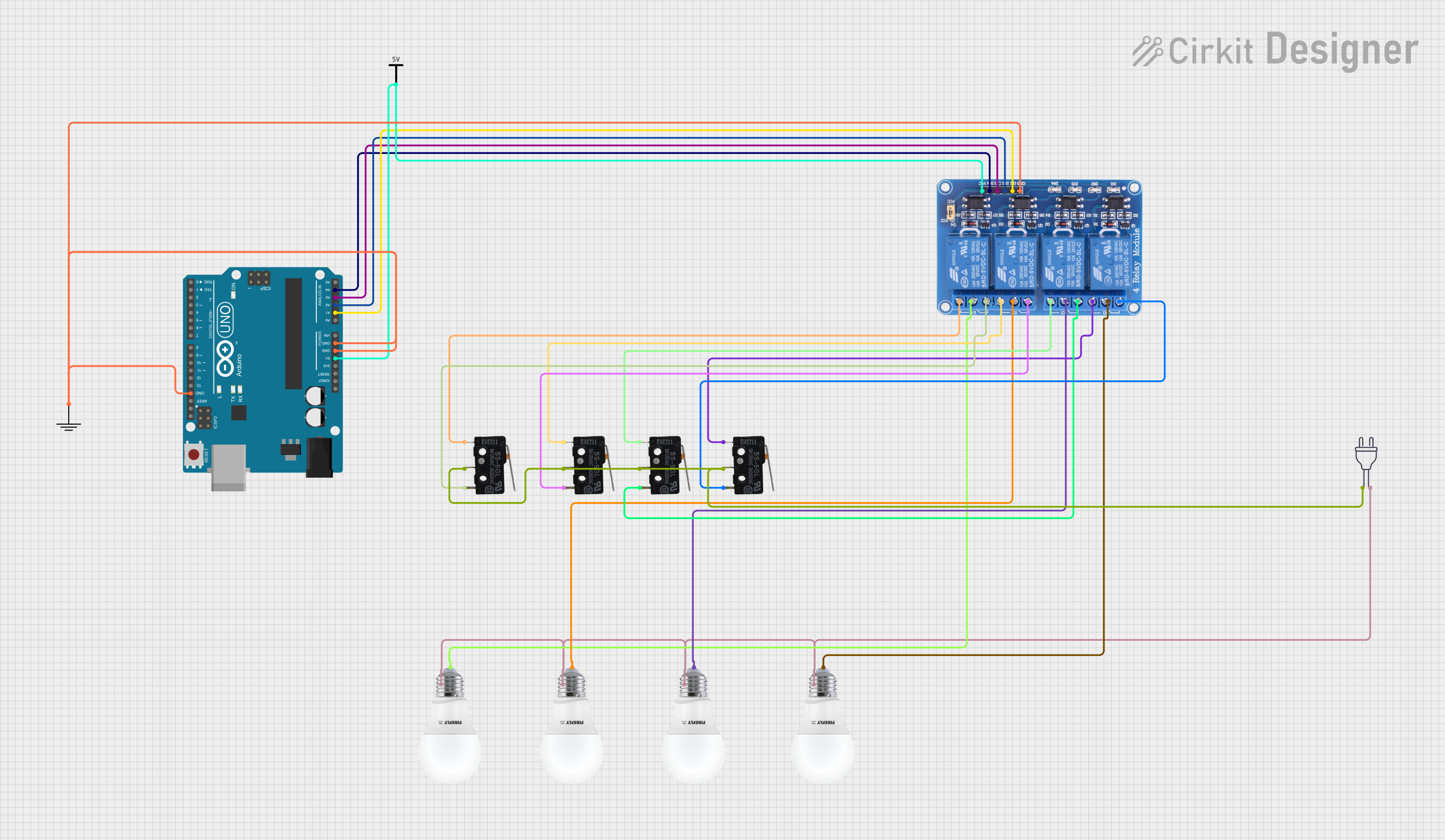
This circuit uses an Arduino UNO to control a 4-channel relay module, which in turn controls four bulbs. Each relay channel is connected to a bulb and can be toggled by corresponding micro switches, allowing for manual control of the bulbs.
 Open Project in Cirkit Designer
Open Project in Cirkit DesignerESP32-Controlled 4-Channel Relay Module
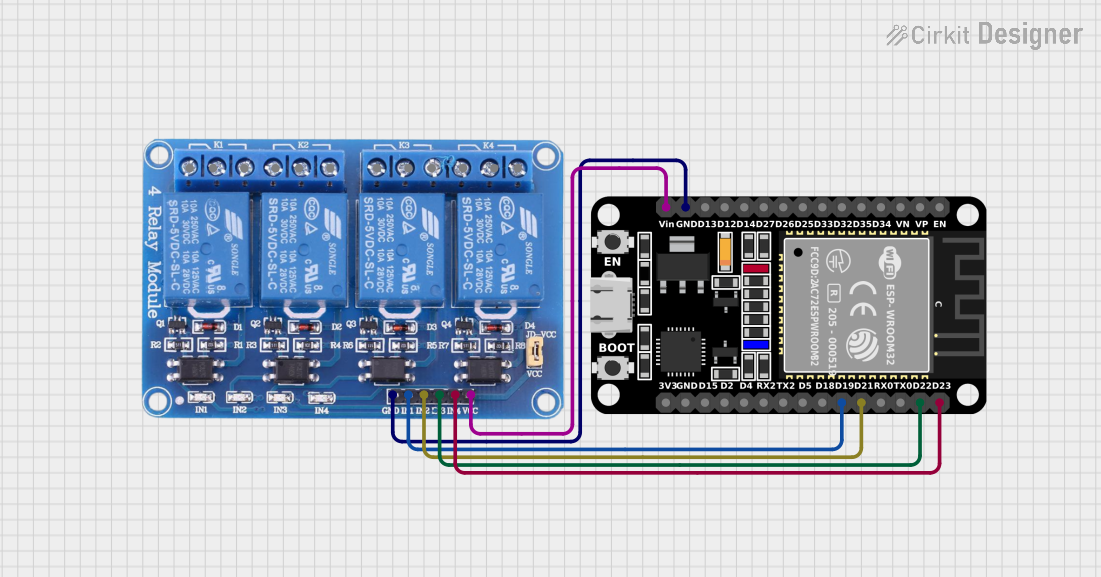
This circuit connects an ESP32 microcontroller to a 4-channel 5V relay module. The ESP32's digital pins (D19, D21, D22, D23) are used to control the relay channels (IN1, IN2, IN3, IN4) respectively. The circuit is designed to allow the ESP32 to switch external devices on and off via the relay module.
 Open Project in Cirkit Designer
Open Project in Cirkit DesignerESP32-POE-ISO Wi-Fi Controlled 4-Channel Relay Module
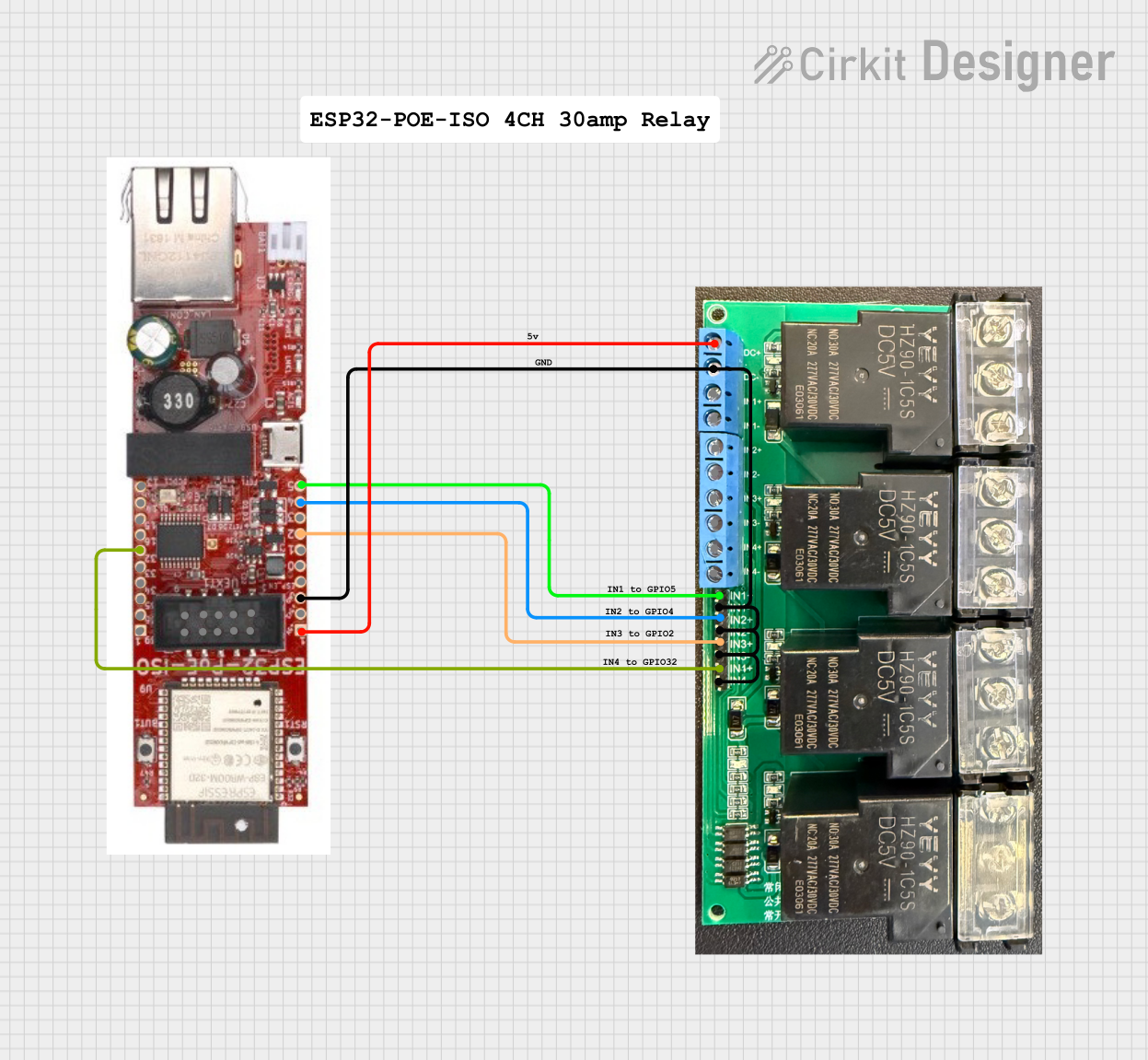
This circuit features an ESP32-POE-ISO microcontroller connected to a 4-channel 30A 5V relay module. The ESP32 controls the relay channels via its GPIO pins, allowing for the switching of high-power devices through the relay module.
 Open Project in Cirkit Designer
Open Project in Cirkit DesignerExplore Projects Built with 4way channel relay

Battery-Powered 4-Channel Relay Control with LED Indicators
This circuit consists of a 5V battery powering a 4-channel relay module, which controls four LEDs (red, yellow, green, and blue) through individual resistors. Each relay channel is activated by a corresponding SPST toggle switch, allowing manual control of the LEDs.
 Open Project in Cirkit Designer
Open Project in Cirkit Designer
Arduino UNO Controlled Smart Lighting System with Relay and Micro Switches
This circuit uses an Arduino UNO to control a 4-channel relay module, which in turn controls four bulbs. Each relay channel is connected to a bulb and can be toggled by corresponding micro switches, allowing for manual control of the bulbs.
 Open Project in Cirkit Designer
Open Project in Cirkit Designer
ESP32-Controlled 4-Channel Relay Module
This circuit connects an ESP32 microcontroller to a 4-channel 5V relay module. The ESP32's digital pins (D19, D21, D22, D23) are used to control the relay channels (IN1, IN2, IN3, IN4) respectively. The circuit is designed to allow the ESP32 to switch external devices on and off via the relay module.
 Open Project in Cirkit Designer
Open Project in Cirkit Designer
ESP32-POE-ISO Wi-Fi Controlled 4-Channel Relay Module
This circuit features an ESP32-POE-ISO microcontroller connected to a 4-channel 30A 5V relay module. The ESP32 controls the relay channels via its GPIO pins, allowing for the switching of high-power devices through the relay module.
 Open Project in Cirkit Designer
Open Project in Cirkit DesignerTechnical Specifications
Key Technical Details
| Parameter | Value |
|---|---|
| Operating Voltage | 5V DC |
| Trigger Voltage | 5V DC |
| Current Consumption | 70-80mA per relay |
| Relay Type | SPDT (Single Pole Double Throw) |
| Max Switching Voltage | 250V AC / 30V DC |
| Max Switching Current | 10A |
| Dimensions | 75mm x 55mm x 19mm |
| Weight | 60g |
Pin Configuration and Descriptions
| Pin Number | Pin Name | Description |
|---|---|---|
| 1 | IN1 | Control signal for Relay 1 (Active Low) |
| 2 | IN2 | Control signal for Relay 2 (Active Low) |
| 3 | IN3 | Control signal for Relay 3 (Active Low) |
| 4 | IN4 | Control signal for Relay 4 (Active Low) |
| 5 | GND | Ground |
| 6 | VCC | Power supply (5V DC) |
| 7 | COM1 | Common terminal for Relay 1 |
| 8 | NO1 | Normally Open terminal for Relay 1 |
| 9 | NC1 | Normally Closed terminal for Relay 1 |
| 10 | COM2 | Common terminal for Relay 2 |
| 11 | NO2 | Normally Open terminal for Relay 2 |
| 12 | NC2 | Normally Closed terminal for Relay 2 |
| 13 | COM3 | Common terminal for Relay 3 |
| 14 | NO3 | Normally Open terminal for Relay 3 |
| 15 | NC3 | Normally Closed terminal for Relay 3 |
| 16 | COM4 | Common terminal for Relay 4 |
| 17 | NO4 | Normally Open terminal for Relay 4 |
| 18 | NC4 | Normally Closed terminal for Relay 4 |
Usage Instructions
How to Use the Component in a Circuit
- Power Supply: Connect the VCC pin to a 5V DC power supply and the GND pin to the ground.
- Control Signals: Connect the IN1, IN2, IN3, and IN4 pins to the digital output pins of a microcontroller (e.g., Arduino UNO).
- Load Connections: Connect the devices or loads to the NO (Normally Open) or NC (Normally Closed) terminals of each relay, depending on your requirements. The COM (Common) terminal is the shared connection point.
Important Considerations and Best Practices
- Ensure that the power supply voltage is stable and within the specified range (5V DC).
- Use appropriate flyback diodes across the relay coils to protect the microcontroller from voltage spikes.
- Avoid exceeding the maximum switching voltage and current ratings to prevent damage to the relay module.
- Use proper insulation and safety measures when dealing with high voltage AC loads.
Example Code for Arduino UNO
/*
Example code to control a 4-way channel relay module using Arduino UNO.
This code will sequentially turn on and off each relay with a 1-second delay.
*/
const int relay1 = 2; // Pin connected to IN1
const int relay2 = 3; // Pin connected to IN2
const int relay3 = 4; // Pin connected to IN3
const int relay4 = 5; // Pin connected to IN4
void setup() {
// Initialize the relay control pins as outputs
pinMode(relay1, OUTPUT);
pinMode(relay2, OUTPUT);
pinMode(relay3, OUTPUT);
pinMode(relay4, OUTPUT);
// Set all relays to off (HIGH state)
digitalWrite(relay1, HIGH);
digitalWrite(relay2, HIGH);
digitalWrite(relay3, HIGH);
digitalWrite(relay4, HIGH);
}
void loop() {
// Turn on Relay 1
digitalWrite(relay1, LOW);
delay(1000); // Wait for 1 second
// Turn off Relay 1 and turn on Relay 2
digitalWrite(relay1, HIGH);
digitalWrite(relay2, LOW);
delay(1000); // Wait for 1 second
// Turn off Relay 2 and turn on Relay 3
digitalWrite(relay2, HIGH);
digitalWrite(relay3, LOW);
delay(1000); // Wait for 1 second
// Turn off Relay 3 and turn on Relay 4
digitalWrite(relay3, HIGH);
digitalWrite(relay4, LOW);
delay(1000); // Wait for 1 second
// Turn off Relay 4
digitalWrite(relay4, HIGH);
delay(1000); // Wait for 1 second
}
Troubleshooting and FAQs
Common Issues Users Might Face
- Relays Not Activating: Ensure that the control signals are correctly connected and that the microcontroller is providing the correct voltage levels.
- Power Supply Issues: Verify that the power supply is stable and within the specified range (5V DC).
- Load Not Switching: Check the connections to the NO, NC, and COM terminals and ensure that the load does not exceed the relay's maximum ratings.
Solutions and Tips for Troubleshooting
- Check Connections: Double-check all wiring connections to ensure they are secure and correctly placed.
- Measure Voltages: Use a multimeter to measure the voltage at the control pins and the power supply to ensure they are within the specified range.
- Inspect Code: Review the code to ensure that the correct pins are being used and that the logic is correct.
- Test Relays Individually: Test each relay individually to isolate any issues with specific relays or connections.
By following this documentation, users should be able to effectively utilize the 4-Way Channel Relay Module in their projects, ensuring reliable and efficient control of multiple devices or loads.